- Afrikaans
- Albanian
- Amharic
- Arabic
- Armenian
- Azerbaijani
- Basque
- Belarusian
- Bengali
- Bosnian
- Bulgarian
- Catalan
- Cebuano
- China
- China (Taiwan)
- Corsican
- Croatian
- Czech
- Danish
- Dutch
- English
- Esperanto
- Estonian
- Finnish
- French
- Frisian
- Galician
- Georgian
- German
- Greek
- Gujarati
- Haitian Creole
- hausa
- hawaiian
- Hebrew
- Hindi
- Miao
- Hungarian
- Icelandic
- igbo
- Indonesian
- irish
- Italian
- Japanese
- Javanese
- Kannada
- kazakh
- Khmer
- Rwandese
- Korean
- Kurdish
- Kyrgyz
- Lao
- Latin
- Latvian
- Lithuanian
- Luxembourgish
- Macedonian
- Malgashi
- Malay
- Malayalam
- Maltese
- Maori
- Marathi
- Mongolian
- Myanmar
- Nepali
- Norwegian
- Norwegian
- Occitan
- Pashto
- Persian
- Polish
- Portuguese
- Punjabi
- Romanian
- Russian
- Samoan
- Scottish Gaelic
- Serbian
- Sesotho
- Shona
- Sindhi
- Sinhala
- Slovak
- Slovenian
- Somali
- Spanish
- Sundanese
- Swahili
- Swedish
- Tagalog
- Tajik
- Tamil
- Tatar
- Telugu
- Thai
- Turkish
- Turkmen
- Ukrainian
- Urdu
- Uighur
- Uzbek
- Vietnamese
- Welsh
- Bantu
- Yiddish
- Yoruba
- Zulu
Sep . 22, 2024 03:46 Back to list
cast steel pipe mold bottom ring
The Importance of Cast Steel Pipe Mold Bottom Rings
In the manufacturing of cast steel pipes, one of the overlooked components is the bottom ring of the mold. Often taken for granted in the assembly line, the bottom ring plays a critical role in ensuring the quality and precision of cast steel pipes. This article highlights the significance of cast steel pipe mold bottom rings, including their functions, materials, and benefits.
Functionality
The primary function of a bottom ring in a cast steel pipe mold is to provide structural support during the casting process. The bottom ring helps to contain the molten steel, ensuring that it flows uniformly and fills the mold cavity without any interruptions. A well-designed bottom ring minimizes the risk of defects such as air pockets, inclusions, or irregularities along the inner surface of the pipe. This is crucial for producing high-quality steel pipes that meet strict industry standards.
Moreover, the bottom ring aids in the thermal insulation of the molten metal. By retaining heat, it helps in achieving a consistent solidification rate, which is essential for maintaining the mechanical properties of the finished product. Any fluctuations in temperature can lead to weak points or fractures in the cast steel pipe, so proper design and material choice for the bottom ring are vital.
Materials
The materials used for manufacturing bottom rings vary but typically include high-grade cast steel or other alloys that can withstand high temperatures and provide durability. The choice of material is crucial; it needs to resist thermal expansion and contraction while maintaining its integrity under the stress of molten metal.
cast steel pipe mold bottom ring

Moreover, the surface treatment of the bottom ring can significantly influence its performance. Coatings that reduce friction, for instance, can make it easier to release the cast pipe once it has cooled, facilitating quicker turnaround times in production.
Benefits
Using an effective bottom ring design offers several benefits. First, it enhances the overall efficiency of the casting process. By reducing the risk of defects, manufacturers can decrease waste and save on material costs. This leads to a more sustainable manufacturing approach, which is increasingly important in today’s environmentally-conscious market.
Second, the reliability of the bottom ring contributes to the longevity of the mold itself. A well-constructed bottom ring can withstand multiple casting cycles without significant wear and tear, providing manufacturers with a cost-effective solution over time.
Finally, the standardization of bottom ring designs allows for easier incorporation into various casting systems. As the demand for cast steel pipes grows, having a consistent and effective bottom ring design can streamline production processes across different facilities.
Conclusion
In conclusion, the cast steel pipe mold bottom ring is an essential component in the manufacturing of high-quality steel pipes. Its contributions to structural integrity, thermal management, and overall efficiency highlight its importance in the production process. Manufacturers who invest in quality bottom rings can see improved productivity, reduced waste, and ultimately, better products reaching the market. As technology continues to advance, the development of innovative bottom ring designs will be crucial in meeting the growing demands of the steel industry.
-
8mm Thin-Walled Cast Steel Manhole Cover Pallet Bottom Ring | Durable
NewsAug.04,2025
-
Premium Cast Iron Water Main Pipe: Durable, Corrosion-Resistant
NewsAug.03,2025
-
Durable Cast Iron Water Mains | AI-Optimized Systems
NewsAug.02,2025
-
High-Efficiency Propane Boiler for Baseboard Heat | Save Energy
NewsAug.01,2025
-
Premium Source Suppliers for Various Gray Iron Castings
NewsJul.31,2025
-
Durable Cast Iron Water Main Pipes | Long-Lasting
NewsJul.31,2025


